I was recently invited to peer inside an Uptown Saint John home and decided to say thanks with some research for the family. In doing so, I stumbled upon these 1890 newspaper excerpts from our beloved Provincial Archives of New Brunswick (I put text in bold) and now I am obsessed with Robert Dwyer:
- “Robert DWYER, St. John boy who left here 23 years ago and went West is now in the city visiting relatives. Mr. Dwyer is a guest of his cousin, Officer HARRINGTON of the police force. He prospered in the west and is now a wealthy resident of Colorado. For a time he was marshall [sic] of the town of Durango and a gold badge with diamond settings was presented to him by the citizens. For some years he has been engaged in ranching and is also interested in some mining operations. Matthew HARRINGTON of Indiantown [direct text from the newspaper referring to the old north end] is with him in the ranching business. He will remain here about a fortnight”; and,
- “Twenty-Three years ago, Robert DWYER, then 20 years of age and employed piling lumber at the old Indiantown mill, took it into his head to go west. Today he is a wealthy man. Some time after leaving here he struck into Colorado. Mr. Dwyer settled in a town called Durango. In 1880 the cowboys had practically control of the place and the authorities were unable to protect life and property. The better class of citizens determined to take action and it was decided to organize a regular police force. Mr. Dwyer was waited on by the leading people and asked to accept the position of marshal, which he did. Having gathered about him a good body of men, he at once set about to restore order. Dwyer is the first cousin of Officer HARRINGTON of the police force. In the cholera, Mr. Dwyer lost his father and he took up his home with Mr. Harrington’s parents and resided with them until he went west.”
I love that Dwyer lived in the north end, had a badge with diamonds gifted to him by the citizens of Durango, and was related to the Harrington family. I want to know more. And can you believe I can share a pic of the diamond encrusted badge!!! The article had me at diamonds.
Animas Museum – La Plata County Historical Society, Durango Colorado – B&W photo of badge (a.): 6-point star with black lettering “MARSHAL/DURANGO COL.” hung by chains from pin bar engraved “Robert Dwyer” with scrollwork surrounding; (b) cream-colored painted bamboo-pattern frame, mat with brown line around opening, glass, screw-eye hanger on top – 95.02.17.

Images of Robert Dwyer below from the Animas Museum. I secured approval to publish and paid for the rights to do so. The Animas Museum is exceptionally helpful, if you want copies please reach out to the kind staff directly.
Animas Museum – La Plata County Historical Society, Durango Colorado – B&W photo of Robert Dwyer with a large mustache & goatee wearing stiff front shirt with studs, suit with vest – 92.19.18.
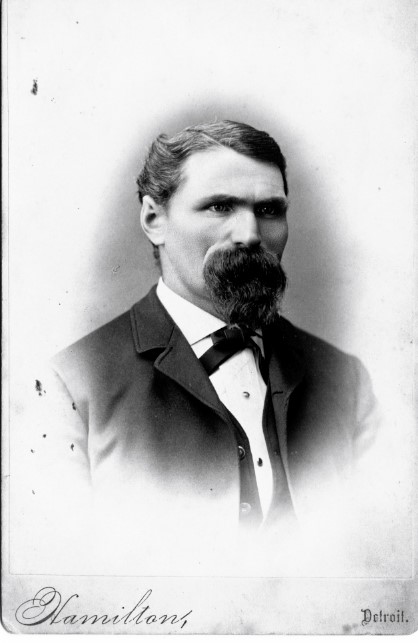
Animas Museum – La Plata County Historical Society, Durango Colorado – B&W studio portrait Robert Dwyer, area
pioneer and sheriff of La Plata County; mounted on dark gray board – 88.22.1.
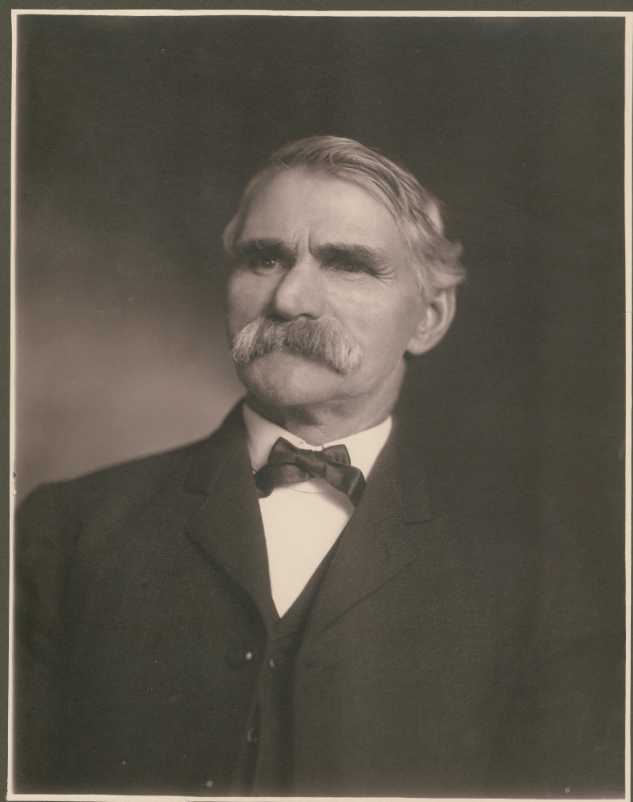
Note: being Canadian I was surprised to find Dwyer elected sheriff as a Democrat. I did not know that party and position came together on the ballot.
My research indicates Robert Dwyer was born in Ireland sometime around Dec 1847 (I have read varying documents suggesting a birth between 1844-1851). Robert lived his early life in Saint John, NB [his obituary indicates he came to Canada in 1850 with his mother Mary nee Crawley as his father John Dwyer had been killed in a mine – none of this is confirmed].
I note that there was an orphan age 10 (born ca. 1844) admitted to the Saint John Almhouse in 1854 named John Dwyer, from Portland [now the north end of Saint John]. I wonder if this is the same John Dwyer as we know Dwyer lived in the north end as did the Harrington family who he later lived with.
The US census records indicate John came to the US around 1868, as does his autobiography referenced below, and various biographies indicate John Dwyer went to Minnesota then Colorado where he eventually got into ranching in La Plata County, Colorado. Note: 1851 and 1861 census records in Canada for the north end of Saint John have not survived.
Robert Dwyer married Mary Jane Clark on 10 Feb 1891 in Scott, Minnesota – after he had returned to Saint John.
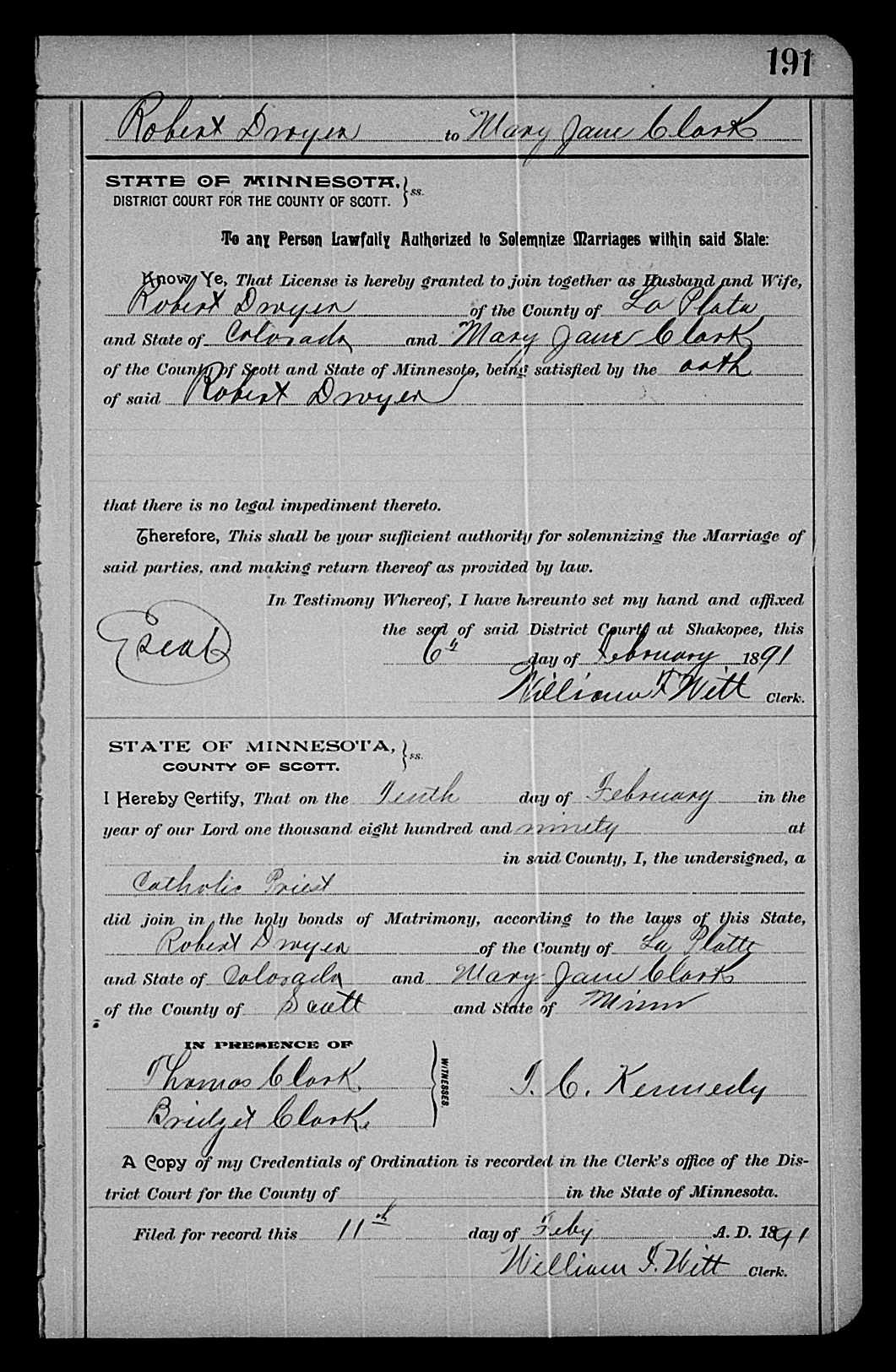
Robert and Mary Jane had sons Robert John, in 1897 and Joseph T. in 1899. Robert died in 1920.
Animas Museum – La Plata County Historical Society, Durango Colorado – B&W studio portrait of Robert Dwyer & Mary Jane (Clarke) Dwyer (1856-1931) sitting, fringed throw over chair back, backdrop to right; he without wedding ring; he was born Dec 1847, they married Feb 1891 – 92.19.34.
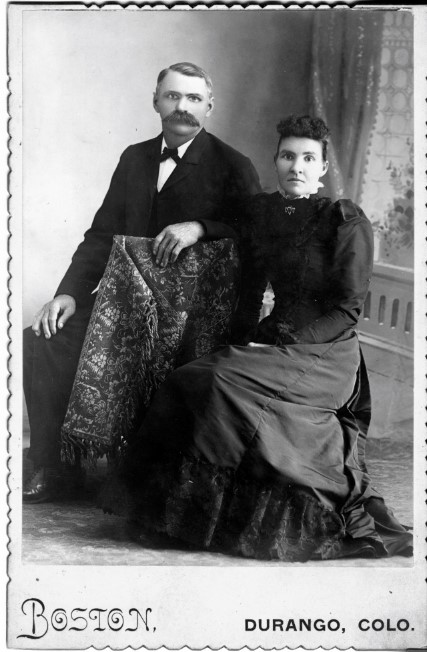
These two newspaper articles art examples give an insight into some of Dwyer’s early experiences in Colorado.
1884:
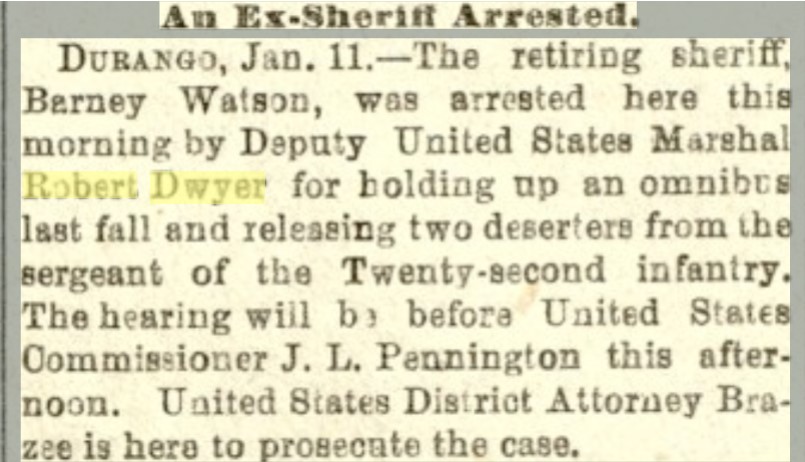
1888:

I paid for the digitization of the Robert Dwyer dictation, BANC MSS P-L 302, The Bancroft Library, University of California, Berkeley and secured permission to publish. Please reach out to the Library of you want to copy – they are so helpful and responsive. See pdf version – cubanc00012234_ae_a – of this 1887 description of Robert Dwyer’s life made on Grand Central Hotel stationary in 1887, just a few years before Robert Dwyer returned to Saint John for a visit.
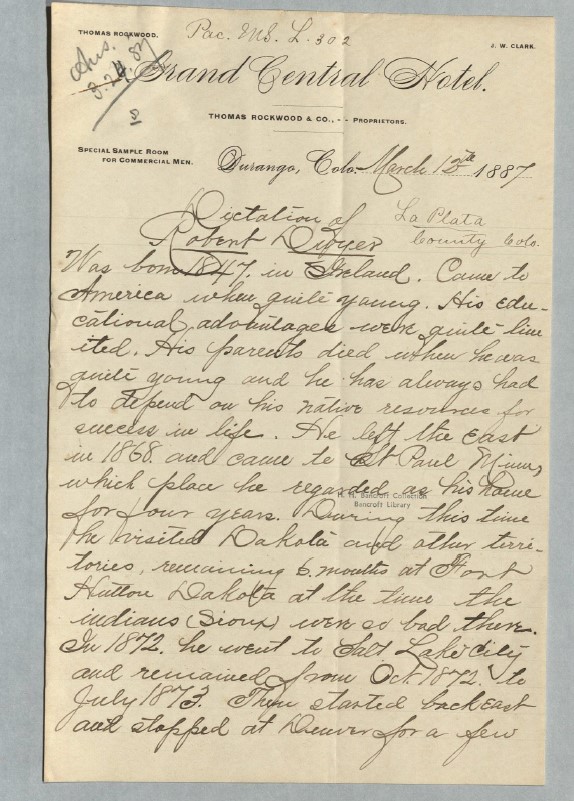
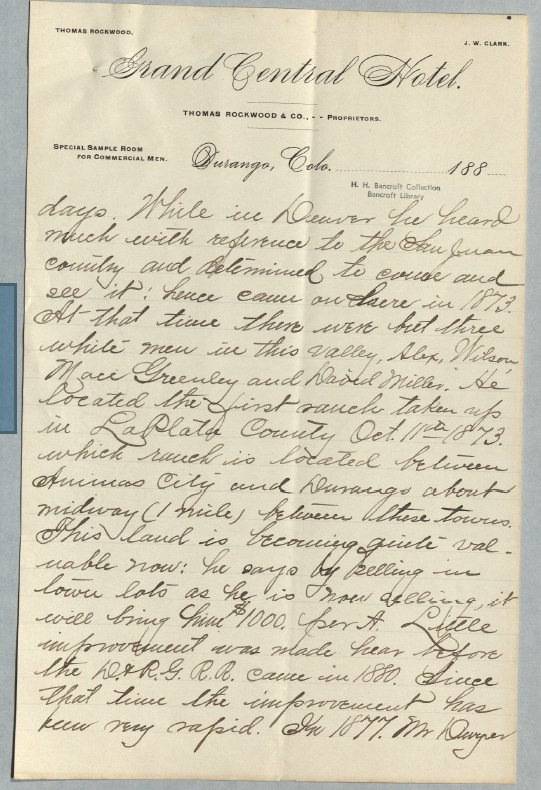
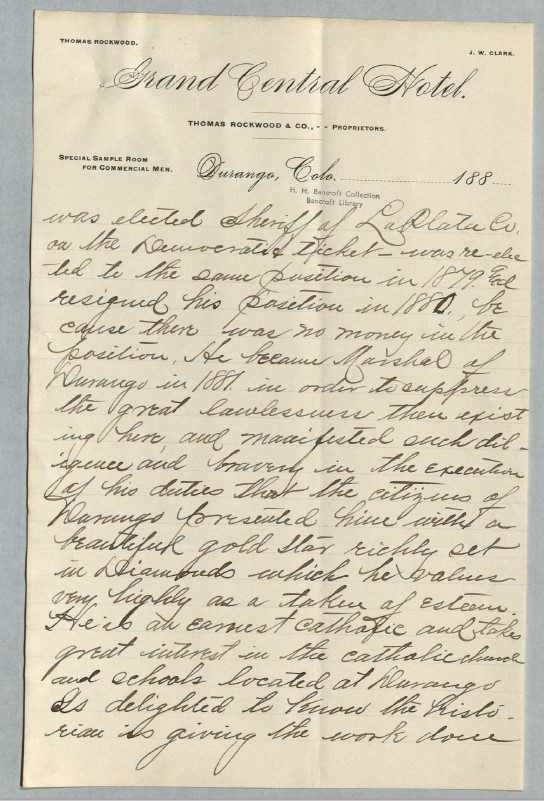
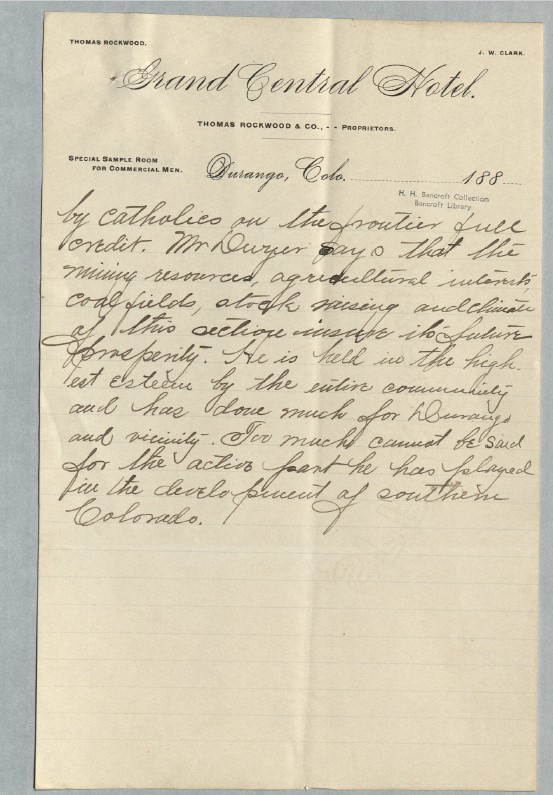
In 1900 Robert and his wife were back in Portland (Saint John) staying with Jeremiah Harrington on Simmonds Street.

For all of us who love architecture (the purpose of my blog), here are pics of Robert’s home in Durango.
Animas Museum – La Plata County Historical Society, Durango Colorado – B&W view of brick Victorian house at 2535 W 2nd Ave (Brookside); owner Robert Dwyer leaning against fence, wife Mary S Dwyer standing inside fenced area near the horse-drawn carriage. Horse tied to post. Bicycle is leaning against the fence on the left hand side – 91.20.4.

B&W brown-tone photo of red brick house, 2535 W 2nd Ave, gables, stained glass windows; standing in front LtoR: Robert Dwyer, wife Mary Jane Dwyer, sons Joseph Dwyer & Robert J Dwyer Jr, dog Tip; fence behind & in front; large elm trees – 92.19.67.
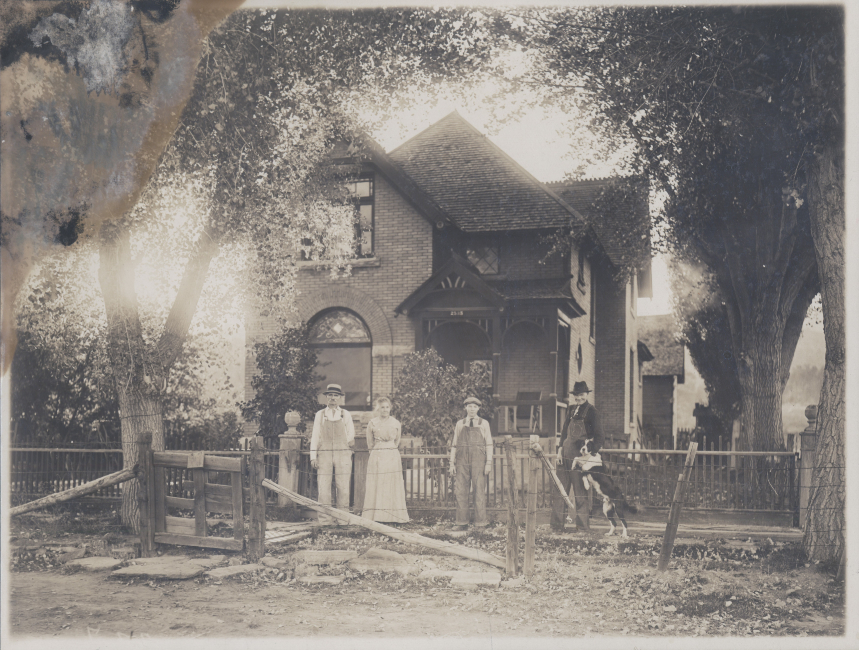
The Durango house is still standing and can be seen on street maps and Trulia.
Robert’s 1920 obituary notes:
Robert Dwyer, Who Played Prominent Part in Catching Criminals in Southwest Colorado, for many Years. Funeral services for Robert Dwyer, the oldest citizen in Durango and one of the most prominent figures: in southwestern Colorado, were held today. He died last week after a prolonged illness, at the age of 72 years. Dwyer was born in County Cork, Ireland, in December, 1847, and came to this country about three years later, shortly after the death of his father and mother. He was raised by Cornelius Harrington, the grandfather of Matt Harrington of this city. After spending some time in Denver and Pueblo, he filed on government land which was purchased by the Ute Indians in 1873. He homesteaded 160 acres of land, part of which includes the town of Durango. He lived on part of this tract until his death. He was elected the first sheriff of La Plata county in 1877 and re-elected the following term, but resigned shortly in order to devote more time to his farming interests. He gained much fame as sheriff and emerged safely from under fire many times. He brought men to Colorado from Utah and New Mexico without requisition. The first prisoners in the county jail at Parrot City were lodged there by him and he took them to Canon City as the first five convicts from La Plata county. In 1874 Mr. Dwyer was appointed by Governor Routt to the position of constable of La Plata county. This was before the town of Durango came into existence. In 1881 he was appointed the first marshal of Durango at a time when the district was full of outlaws and bad men. On June 8, 1881, he received a letter signed by W. Allison, alias Texas Kid, telling him to arrange matters with Nutshell Bill, as the gang needed the coin and were going to Durango. Mr. Dwyer paid no attention to the letter but notified all business places in Durango of the receipt and supplied them with arms and ammunition, which he procured from the United. States troops stationed at Animas City, who had been sent there by the government prior to that time as a protection against an Indian outbreak in 1878. The desperadoes came. Four of them rode quietly thru the town and passed out without any demonstration. It afterwards was learned that the men were members of the Jesse James gang and were after Dwyer and two men at the smelters. In 1888 Mr. Dwyer, while serving as marshal of Durango, was accidentally shot by a policeman, while making an arrest. The bullet, after passing thru the prisoner’s ear, struck Mr. Dwyer at the base of the nose and lodged in his neck, below his ear. He carried the bullet for nearly a year before he had it removed. In 1890 Mr. Dwyer was united in marriage to Miss Mary Clarke, who was born at Belleplains, Minn., a daughter of John and Bridget (Burns) Clarke, who moved to Minnesota from Ireland in 1847. Mr. and Mrs. Dwyer are the parents of two children, Robert, born Sept. 9, 1897, who is now an electrician with a Montana company, stationed near Helena, and Joseph, born Dec. 10, 1899, now employed by the Graden Mercantile company of this city. Both sons were present when their father died. Religiously, Mr. Dwyer was a devout Catholic and politically, he was ‘a staunch Democrat.
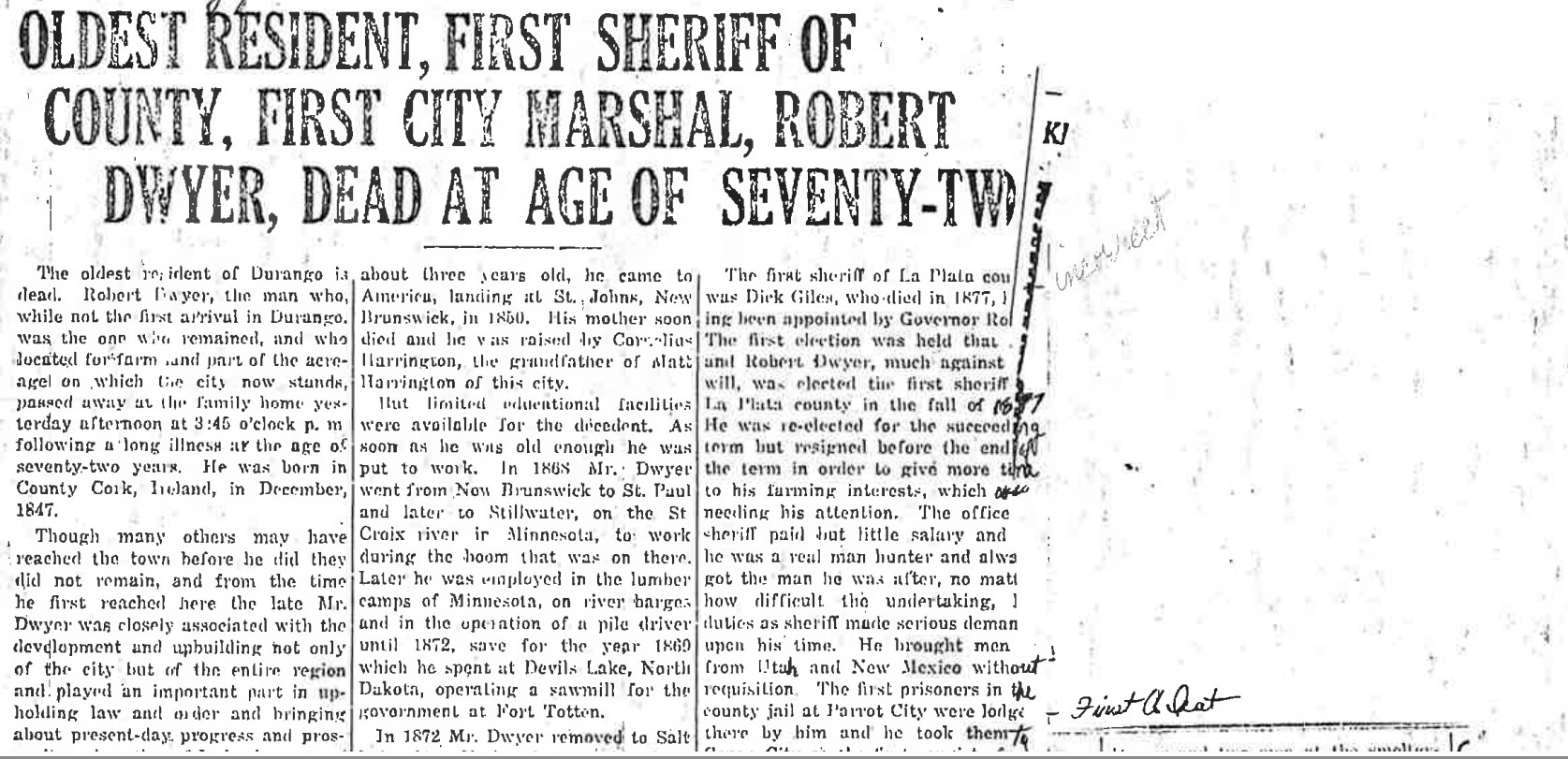

I have not yet found proof of Robert’s baptism, his parents, their coming to Canada, nor the familial connection to the Harrington family. I would like to know more about where he lived in Saint John. I note that in 1869-1870, Cornelius and his son Jeremiah lived on Mill St – did Robert Dwyer live there too before heading west?
I do know that Matthew Harrington, referenced in the 1890 articles as close to Robert, was born ca. 1866 to parents Jeremiah and Mary Jane Harrington. Matthew moved to Durango in 1889.

Jeremiah Harrington (father of Matthew), of the north end [then Portland] was the son of Cornelius Harrington. I did not find Matthew or his parents in the 1871 census, but in the 1881 census Jeremiah was a blacksmith and Matthew was a painter. In 1891, Matthew was noted as a carriage painter – his brother Jeremiah was too young to work. Matthew had left Saint John before the 1901 census. Matthew, or Matt, married American Frances Adelia Rodgers in 1894, and together they raised a family in Colorado. Matt rose to be Superintendent of the Western Colorado Power Company and died in 1929. He is buried in Durango, La Plata County, Colorado, USA in the same cemetery as Robert Dwyer – Greenmount. Of note – Matthew’s parents (Jeremiah and Mary Jane) had a son named Robert D. Harrington – could he have been named after Robert Dwyer?
Of interest, Matthew’s brother Jerry, or Jeremiah, also moved to Durango and died there in 1905 though his body was returned to Saint John.
Obituary: JERRY HARRINGTON. —This morning just before the arrival of the Silverton train for the east, about fifty Elks were in procession on First avenue, leading the hearse that bore the remains of Jerry Harrington, and before the train had arrived there were probably a hundred ‘or more Elks at the depot. The brother, Matt Harrington, so well known “in Durango, was there to make & long journey to St. Johns, New Brunswick, where burial at the old home place is to occur and where the parents now reside, The Harringtons are related to Robert Dwyer, who has fond recollections of their grandparents, and Mr. Dwyer and other family relatives and friends were at the station this morning. The pall bearers were Mayor C. E. McConnell, George Logan, James Callery, James J. Gormam, H. D, Mc Bride and Oscar Maher, all brother Elks. Matt Harrington said it would be some time before he could reach his new home again at Marysville, Kas.
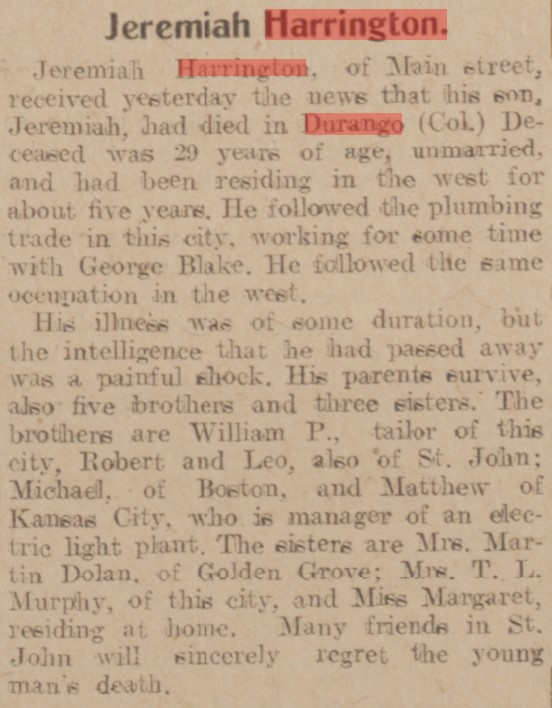
It bothers me that Robert Dwyer’s parents are not known. I hope the connection to the Harringtons help me solve this mystery. I am impressed with how Dwyer survived and thrived past the early tragedies of his life, and I am excited to think about this hard working Saint Johnner.